There are six venomous snake species in Arkansas. It’s vital for outdoors people to know how to identify and stay safe around them. Among these are three rattlesnake species, a cottonmouth, a copperhead, and a coral snake. Each of these snakes poses potential risks. In fact, an average of 307 people are bitten by Arkansas’ venomous snakes each year. Understanding their appearance, behavior, and habitats can help you navigate the outdoors safely.
In this guide, you’ll learn how to recognize these snakes, their behaviors, and their habitats across Arkansas. Whether you’re a hiker, camper, or simply curious about local wildlife, this comprehensive resource will equip you with the knowledge to stay safe and informed.
Pit Vipers: The Venomous Masters of Infrared Detection
Rattlesnakes, Copperheads, and Cottonmouths are among the members of the Crotalinae subfamily of the Viperidae family of venomous snakes, also referred to as pit vipers. These snakes are equipped with unique adaptations that make them exceptional hunters.
What Makes Pit Vipers Unique?
- Infrared-Sensing Pits:
A defining feature of pit vipers is the deep facial pit between their nostril and the eye on each side of their head. These specialized infrared-detecting organs allow pit vipers to sense heat emitted by prey. This adaptation enables them to:- Detect body heat from up to 1 meter away.
- Strike prey with pinpoint accuracy, even in complete darkness.
- Triangular Heads and Vertical Pupils:
- Head Shape: Pit vipers are recognized by their distinct triangular-shaped heads, which house their venom glands.
- Eyes: They have vertical elliptical-shaped pupils.
- Venomous Fangs:
Pit vipers have hollow fangs connected to venom glands. These fangs fold back against the roof of their mouth when not in use.
Ecological Importance
Pit vipers serve as a check to rodent populations. Despite their fearsome reputation, these snakes are vital to the health of many habitats.
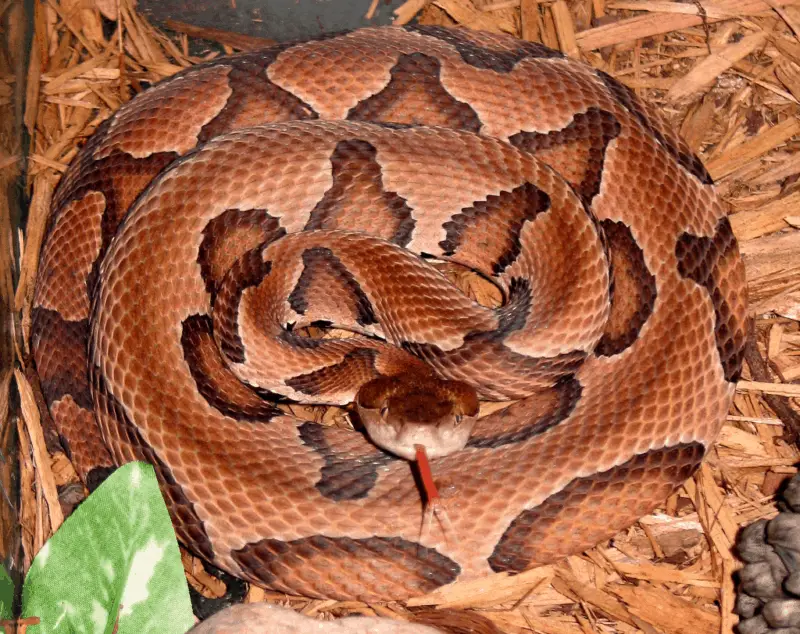
Eastern Copperhead (Agkistrodon contortrix)
The Eastern Copperhead is a pit viper native to the eastern and mid-western United States.
What Do Eastern Copperheads Look Like?
| Coloration | *Reddish-tan to grayish-tan bodies. *Overlaid with dark brown, hourglass-shaped markings. *Heads are dark coppery brown, giving them the name “Copperhead.” |
| Body Shape | *Stout and heavy-bodied snakes. *As with all pit vipers, their heads are triangular and appear oversized in relation to their necks. |
| Size | *Adults range from 20 to 37 inches (50 to 95 cm) in length. |
Taxonomy of Alabama’s Eastern Copperhead Snakes
Copperhead snakes are found across Alabama and are now recognized as a single species: the Eastern Copperhead (Agkistrodon contortrix).
In the past, these snakes were classified into different subspecies, including the Northern Copperhead, Southern Copperhead, and Osage Copperhead. However, recent DNA studies revealed minimal genetic differences between them. As a result, these subspecies were combined into a single taxonomic group under the Eastern Copperhead name.
Where Do Eastern Copperheads Live in Arkansas?
Eastern Copperhead snakes live throughout the state of Arkansas. They live in pine-hardwood forests, floodplain hardwood forests, brushy fields, and rocky hillsides.
Eastern Copperhead Behavior
Copperheads are dangerous because they use camouflage as their number one defense mechanism. In other words, these snakes choose to lie perfectly still rather than flee most of the time. Their camouflage helps them blend in with leaf litter and other ground debris.
When they feel threatened, they occasionally mimic the tail vibration of a rattlesnake. But, in most cases, they choose to lie perfectly still.
Most copperhead bites on humans occur when the person steps on or near the snake.
What Do Copperheads Eat?
Copperhead snakes are opportunistic feeders. They eat insects, spiders, frogs, small rodents, birds, and other reptiles.
How Dangerous are Copperheads?
A Copperhead can bite and inject venom when they are newly born. Like most pit vipers, they have hemotoxic venom.
Most copperhead bites are not life-threatening. On the other hand, any bite from this snake is a medical emergency and should be treated as such. If a copperhead bite victim gets medical help fast, they have a better chance of a positive outcome.
Copperhead bites can cause intense pain, shock, and swelling. Their bites also have the potential to cause blood in urine, tissue damage, and kidney failure.
An interesting study has found that Copperhead venom contains a protein called contortrostatin. Contortrostatin has been found to stop the growth of cancer cells in mice.
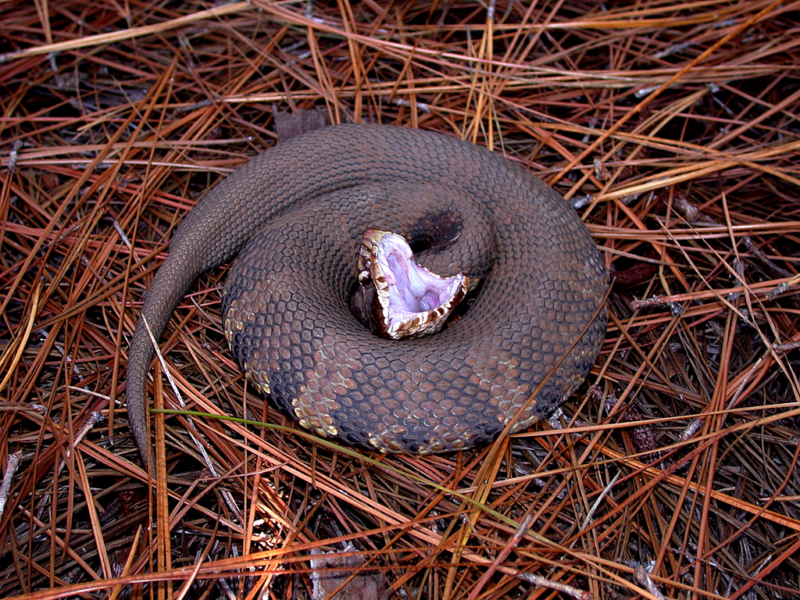
Northern Cottonmouth (Agkistrodon piscivorus)
Another common name for the Northern Cottonmouth is water moccasin. They look a little bit like rattlesnakes without the rattle on the tail. People also sometimes mistake them for common water snakes. This could be a dangerous mistake.
What Do Northern Cottonmouths Look Like?
| Coloration | *Adults: Dark brown to black body with minimal markings. *Inside of the mouth: White, giving them the name “cottonmouth.” *Juveniles: More defined patterns, resembling a copperhead with darker bands that widen toward the belly and narrow along the back |
| Body Shape | *Stout, muscular snakes. |
| Size | *These snakes grow up to 3 feet (0.91 m) in length. |
| Distinctive Features | *Pupils are cat-like and elliptical, appearing as narrow slits during the day. At night, pupils appear round. |
| Behaviors | *Cottonmouths arc their heads upward and display an open-mouthed pose when agitated. This exposes the white interior of their mouth. This is a warning to back off or suffer the consequences. *Interestingly, they can hold their breath underwater for up to an hour while hunting for prey. |
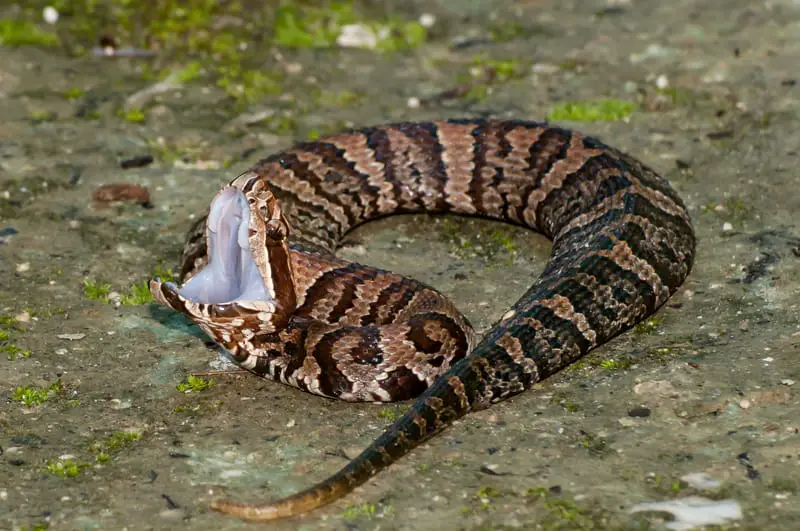
Where Do Arkansas’ Northern Cottonmouths Live?
Cottonmouths range throughout much of Arkansas. They are semi-aquatic snakes. They usually hang out near swamps, drainage ditches, slow-moving rivers, and lakes.
Cottonmouths sometimes venture overland. It’s not unheard of to see one far from any aquatic environment.
What Do Cottonmouths Eat?
These snakes prey on fish, freshwater crustaceans, amphibians, small mammals, and other reptiles. Cottonmouths sometimes congregate around drying wetland pools to feed on any trapped fish. Interestingly, they can hold their breath underwater for up to an hour while hunting for prey.
How Dangerous are Cottonmouths?
Cottonmouth venom is cytotoxic. This means it destroys body tissue. Cottonmouth bites sometimes lead to the amputation of limbs. On rare occasions, death can occur.
Rattlesnakes of Arkansas
Here’s a list of the three rattlesnake species in Arkansas.
- Western Diamondback Rattlesnake (Crotalus atrox)
- Timber Rattlesnake (Crotalus horridus)
- Western Pygmy Rattlesnake (Sistrurus miliarius streckeri)
What Arkansas rattlesnakes have in common with most other rattlesnake species is their rattle.
- Most rattlesnakes have a rattle at their tail’s end, comprised of hollow, loosely interlocked keratinous scales.
- Normally, a rattlesnake adds a new segment to its rattle each time it sheds its skin.
- An agitated rattlesnake rapidly vibrates its tail, causing the segments of its rattle to vibrate together, creating a buzzing or rattling sound.
- Not all of Arkansas’ rattlesnakes rattle before they strike. Sometimes, they lose their rattles due to injury, and sometimes, they choose not to rattle.
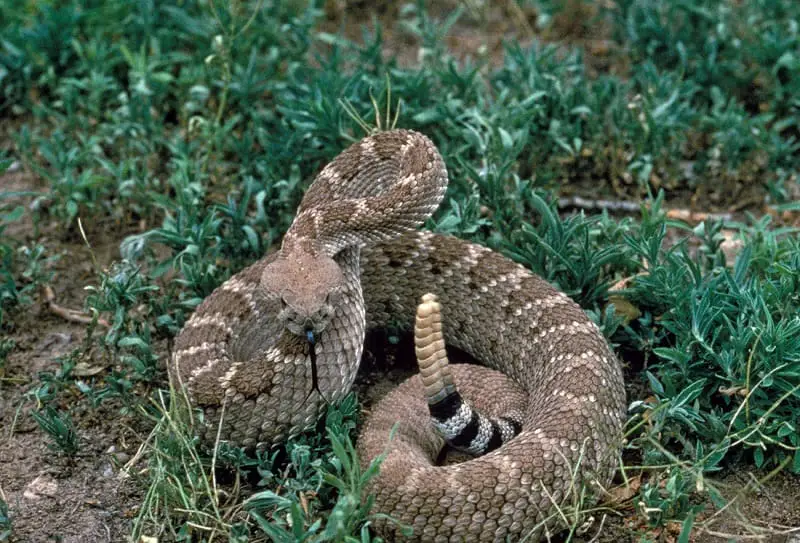
Western Diamondback Rattlesnake (Crotalus atrox)
(Also known as the Western Diamond-backed Rattlesnake or Adobe Snake.)
What Do Western Diamondback Rattlesnakes Look Like?
| Size | Grows from 4 ft to 7 ft (1.22 to 2.13 m) in length. Average weight: 3 to 6 lb (1.23 to 2.7 kg) |
| Coloration | *Base colors: Yellow, light brown, salmon, gray, gray-brown, cream, or olive. *Dark diamond-shaped patterns along the back give it the name “Diamondback.” *A dark line runs from the corner of the mouth to behind the eye. |
| Dorsal spots | *Edges are darker than the base color. *Centers are slightly darker than the base color. |
| Tail | *Features two to eight black bands separated by pale gray bands. *Like all rattlesnakes except the Santa Catalina Island Rattlesnake, Western Diamondbacks have loosely connected, hollow keratinous scales on the ends of their tails. These hollow scales are also known as rattles. When the snake is agitated, it vibrates its rattles to create a warning buzzing sound. |
Where Do Western Diamondbacks Live?
The Western Diamondback Rattlesnake’s range in the U.S. begins in Arkansas and Oklahoma. It then stretches to the west and takes in parts of Texas, New Mexico, Arizona, Nevada, Utah, and California.
In Arkansas, Western Diamondback Rattlesnakes live in the west-central part of the state. They live in diverse habitats such as plains, rocky regions, and forests.
How Dangerous are Western Diamondback Rattlesnakes?
Western Diamondback Rattlesnake venom is Hemotoxic, cytotoxic, and myotoxic. If a Western Diamondback bite goes untreated, it can cause serious problems. These include severe internal bleeding and tissue damage, which might result in gangrene.

Timber Rattlesnake (Crotalus horridus)
Timber Rattler and Canebrake Rattlesnake are both common names for the Timber Rattlesnake. Generally, in higher-elevation habitats, they are called Timber Rattlesnakes. On the coastal plain, though, they’re called Canebrake Rattlesnakes.
What Do Timber Rattlesnakes Look Like?
| Size | *Average length: 36 to 60 inches (0.91 to 1.52 m). *Rare cases reported: Up to 7 feet (2.13 m). |
| Coloration | *General base color: Yellowish-brown to grey-brown. *Chevron pattern: Dark brown to black chevrons on their back and sides against a lighter base color. *Back stripe: Rusty to reddish stripe running down their back. *Tail color: Dark brown or black. |
| Melanistic Variation | *Some timber rattlesnakes exhibit a dark, melanistic color morph. *These snakes can appear almost entirely black. *The tail is darker than the rest of the body in this morph. |
Where Do Timber Rattlesnakes Live in Arkansas?
Timber Rattlesnakes range throughout much of Arkansas, although people rarely run into them. They live in varied environments like mountains, pine forests, swamps, fields, and floodplains.
What Do Timber Rattlesnakes Eat?
Timber rattlers prey on:
- Small mammals such as mice, rats, squirrels, and chipmunks
- Small birds
- Other reptiles and amphibians.
The experts have proven that timber rattlesnakes help control Lyme disease. This is because as they consume rodents, they’re also consuming ticks. A timber rattler will consume 2,500 to 4,500 ticks per year, depending on the location.
These snakes are excellent climbers. In fact, timber rattlers have been found in trees at heights of more than 80 feet.
How Dangerous are Timber Rattlesnakes?
- Timber Rattlesnakes are among the most dangerous in the United States. This is due to their long fangs and high venom yield. 1% to 10% of untreated Timber Rattlesnake bites result in a fatality.
- Fortunately, 40% to 60% of the time, they produce dry bites. In other words, although their fangs penetrate the body, they do not inject any venom.
- These snakes produce hemotoxic venom. Timber Rattlesnake bites sometimes cause serious complications. These include shock, seizures, coma, internal bleeding, and deep tissue damage.
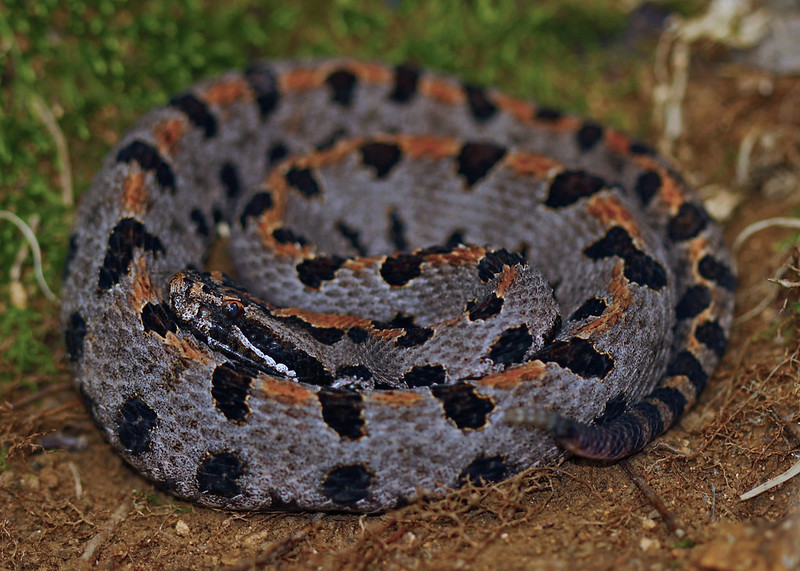
Western Pygmy Rattlesnake (Sistrurus miliarius streckeri)
The Western Pygmy Rattlesnake is a small, slender-tailed snake with a tiny rattle.
What Do Western Pygmy Rattlesnake Look Like?
| Size | *Small, slender-tailed snake with a tiny rattle. *Length: 16 to 25 inches (41 to 64 cm). *Average length: 21.1 inches (54 cm). |
| Coloration and Markings | *Body: Light grayish brown with dark-colored blotches that form crossbars along the top and sides. *Stripe: Rust-colored vertical stripe on the back (may be absent in some individuals). *Belly: Cream-colored, often mottled. *Face: Distinct dark stripe from the corner of the mouth to the eye. |
| Rattle and Sound | *A tiny rattle produces a faint, grasshopper-like buzz. *Sound can only be heard from a few feet away. |
Where are Western Pygmy Rattlesnakes Found in Arkansas?
Western Pygmy Rattlesnakes range throughout much of Arkansas except the extreme eastern border. They live in sandhills, mixed forests, and floodplains. Also, these snakes usually range within a couple of miles of large bodies of water, such as rivers or lakes.
How Dangerous are Western Pygmy Rattlesnakes?
The venom of the Western Pygmy Rattlesnake is cytotoxic. Cytotoxic venom destroys tissue, disrupts blood flow, and prevents blood from clotting. Yet, this snake’s venom yield is so low that it is unlikely that a bite could be fatal. But anyone bitten by this snake should still seek medical attention.
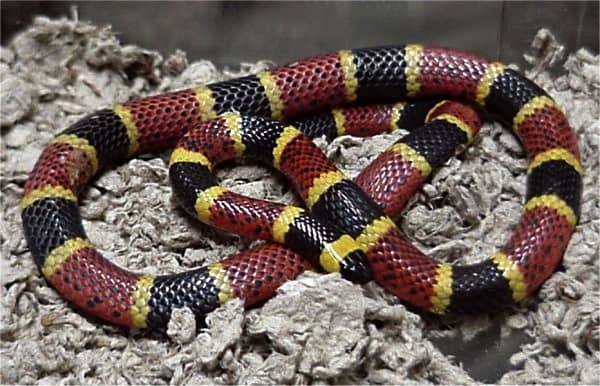
Texas Coral Snake (Micrurus tener)
A fun fact: Texas Coral Snakes are the only venomous snakes in Arkansas that are not pit vipers. Instead, they belong to the Elapidae family. This makes them closely related to Cobras and Mambas.
Texas Coral Snakes live in the southeastern United States. They also live in northeastern and central Mexico. These snakes inhabit the extreme southwestern portion of Arkansas.
What Do Texas Coral Snakes Look Like?
| Size | *Texas Coral Snakes can grow up to 4 feet (122 cm), but most are around 2 feet (61 cm). *Sexually dimorphic: Males are slightly smaller than females. |
| Physical Features | *Rounded heads and noses, with tails that resemble the head. This similarity can make it hard to distinguish the head from the tail. |
| Coloration | *Brightly colored, highly venomous snake. *Bands of black, light yellow, and red. *Yellow bands separate the red and black bands. |
Eye Shape and Family Classification
- Like other Elapid snakes, all coral snakes have round pupils.
- Contrast with other venomous snakes in Arkansas:
- The other five species, with vertical slit-like pupils, are from the Viperidae family.
Lori Monday is a regional educator with the Arkansas Game and Fish Commission. She states that it’s a common miss conception that all venomous snakes have slit pupils. The other five venomous snakes in Arkansas are members of the Viperidae family. As such, they have vertical slit-like pupils. On the other hand, coral snakes are members of the Elapidae family. Elapid snakes have round pupils.
Batesian Mimicry of Coral Snakes
Batesian mimicry is a biological term. It describes how a harmless species protects itself by resembling a dangerous one. For example, kingsnakes, scarlet snakes, and milk snakes are all nonvenomous snakes. However, their color patterns all closely resemble the venomous coral snake. The difference is that a coral snake’s red and yellow bands touch. On the other hand, the nonvenomous species’ color patterns are red, black, and yellow. Also, a coral snake’s head is blunt and entirely black, even behind its eyes, while a Kingsnake’s head is red.
This rhyme helps people distinguish between a nonvenomous species and a coral snake. “Red and yellow can kill a fellow; Red touch black, a friend of Jack.”
Caution: the rhyme is mostly accurate in the United States. However, coral snakes from areas south of the U. S. do not always follow the black-yellow-red pattern. This is also true in Central America, South America, and the Caribbean.
Finally, there are rare coral snakes that do not follow the usual color pattern in the United States. Pink, cream-colored, light blue, and completely black coral snakes exist in the wild.
What Do Texas Coral Snakes Eat?
Texas Coral Snakes primarily eat other snakes and small lizards. It is rare for them to eat rodents.
Texas Coral Snake Behavior
Coral snakes are underground snakes. They spend most of their time buried in the sand, under leaf piles, and in rotten logs.
Defensive Farting
When rattlesnakes are uptight, they rattle their tails. On the other hand, coral snakes react to stress a bit differently.
When coral snakes are agitated, they fart. To do this, they draw air into their cloacas and force it out again. This makes a popping sound.
How Dangerous Are Texas Coral Snakes?
Coral snakes have neurotoxic venom. It is the second most potent snake venom in the world. (The mamba being the most venomous).
However, they are considered less dangerous than rattlesnakes. The reason is that they have a less effective venom delivery system. Their smaller mouth and fangs produce less venom. Yet, a coral snake bite should be taken seriously, and medical treatment should be sought. Sometimes, the manifestation of a severe bite doesn’t present itself for 24 hours.
Alabama’s Venomous Snakes in Winter: Insights into Brumation
During winter, Alabama’s snakes, like all reptiles, enter a dormant state called brumation—a hibernation-like period. Because snakes are ectothermic (cold-blooded) and cannot regulate their body temperature internally, they slow their metabolism and become inactive during the colder months.
Brumation Habits
- Solo vs. Communal Brumation: Some snakes brumate alone, while others gather in communal dens. For example, Eastern Copperheads and Timber Rattlesnakes often share dens, which may house up to 60 snakes.
- Mixed-Species Dens: Interestingly, these dens can include non-venomous species. It’s not uncommon to find non-venomous snakes, such as Black Rat Snakes, sheltering alongside venomous snakes.
Regional Variations
- Snakes may only seek shelter in warmer areas, such as southern and northwestern Arkansas on the coldest days.
Where Snakes Spend Winter
Snakes seek out protected spots to brumate, such as:
- Rock crevices
- Hollow logs
- Fissures on rocky hillsides
They often choose south-facing slopes because these areas receive more sunlight, providing additional warmth during winter.
This natural adaptation allows Arkansas’ venomous snakes to survive the winter and re-emerge when temperatures rise.
Avoiding Snake Bite
The copperhead is the most common venomous snake in Arkansas. These snakes rely on their excellent camouflage to stay hidden. They often remain perfectly still to avoid detection. If you’re walking in the woods and unknowingly get too close, a copperhead might not move, hoping you’ll pass by. Many bites happen when someone accidentally steps on the snake. To stay safe in snake habitats, always watch where you step and where you place your hands.
Another common cause of snake bite is attempts to capture or kill a snake. Remember, venomous snakes can strike instantly, delivering a potentially life-threatening bite. The safest approach is to keep a safe distance and leave them alone.
Dressing for Snake Country
- High-top leather boots and long pants are both wise ideas.
- Also, wear loose-fitting denim. If there’s a gap before the snake’s fangs touch your skin, your chances of being envenomated are lower.
- In the absence of high-top leather boots, some people wear snake gaiters.
Symptoms of Venomous Snake Bites
Some of the symptoms you may experience from a venomous snake bite include:
- Discoloration in the area of the bite.
- Swelling in the area of the bite.
- Loss of muscle coordination.
- Tingling sensation in the area of the bite.
- Feeling nauseous.
- Having an abnormally rapid pulse.
What Should You Do if You Are Bitten?
If you or someone you are with has suffered a venomous snakebite, time is of the essence. This is because the sooner a victim receives anti-venom, the less likely the venom in their body is to cause harm. In other words, it is important to seek immediate medical attention.
Do not attempt to kill the snake for identification purposes. This gives the snake a chance to bite you again. Also, consider that severed snakeheads can still bite and envenomate. If you have a phone, take a picture of the offending reptile. Otherwise, get started on your way to the doctor.
First Aid for Snake Bite Victims
- Remain calm and limit your movements. Do not run. If you must hike back to a vehicle, do it calmly and deliberately. Put as little stress on your heart as possible.
- Keep the area of the snake bite below the heart level and never above the heart level. Keeping the bite below the heart level will reduce the venom’s flow. However, holding the bite above your heart level will increase the venom’s flow.
- Remove all constricting items such as bracelets, watches, or rings before swelling occurs.
- Remember that using a cold compress on a venomous snake bite is not advisable. The reason is that the cold may cause the local blood vessels to constrict and spread the venom faster.
- You can wash the affected area like any other wound with soap and water.
- You may cover the bite area with a moist dressing to reduce the swelling.
- Get medical attention as soon as possible. Call the hospital to tell them a venomous snake has bitten you. So they can have anti-venom ready to give you as soon as you arrive.
- A person whom a venomous snake has bitten may go into shock. If this happens, you should lay them flat and cover them with a blanket.
Conclusion
In conclusion, Arkansas has six species of venomous snakes. These snakes, including the Eastern Copperhead, Northern Cottonmouth, three rattlesnake species, and the Texas Coral Snake, play vital roles in controlling prey populations and maintaining ecological balance. However, they also pose potential dangers to humans due to their venomous bites. Understanding their behaviors, habitats, and appearances allows people to coexist more safely with these reptiles. Awareness, proper precautions, and respect for their role in the ecosystem are key to minimizing risks and appreciating the diversity of Arkansas’s wildlife.
You might also like:
Recent Posts
The only venomous snakes in Washington State are Northern Pacific Rattlesnakes. The Northern Pacific Rattlesnake (Crotalus oreganus oreganus) is a sub-species of the Western Rattlesnake. Anyone...
Skunks are not classified as true hibernators. But they go into a state of torpor when the weather gets cold. Skunks are light sleep hibernators, along with opossums, bears, and raccoons. ...
